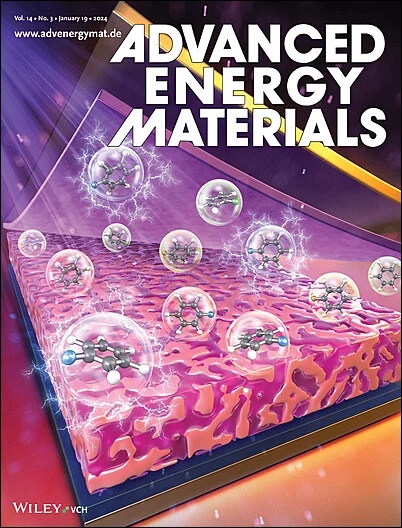Ionically Cross‐Linked Composite Hydrogel Modulating an Electrical Double Layer on Zn Metal Anodes for Enhanced Kinetics and Stability
IF 26
1区 材料科学
Q1 CHEMISTRY, PHYSICAL
引用次数: 0
Abstract
Achieving high interfacial kinetics for Zn metal anodes, without triggering the hydrogen evolution reaction (HER) and corrosion, remains a challenge. Particularly, studies on promoting kinetics in an H

离子交联复合水凝胶在锌金属阳极上调制双电层以增强动力学和稳定性
在不引发析氢反应(HER)和腐蚀的情况下,实现Zn金属阳极的高界面动力学仍然是一个挑战。特别是,在缺乏水的双电层(EDL)中促进动力学的研究是非常罕见的。本研究引入了一种由海藻酸盐(Alg)、聚(2‐丙烯酰胺‐2‐甲基‐1‐丙磺酸)(PAMPS)和聚苯胺(PANI) (APP)组成的大分子水凝胶界面层,通过工程设计Zn上的EDL来解决这一问题。APP层通过聚苯胺促进法拉第过程,如脱溶剂和表面扩散,同时通过H2O -贫和SO42 -贫的EDL抑制HER和腐蚀。电场和离子通量的均匀分布,以及APP提供的高机械稳定性,有效地减缓了Zn枝晶的生长。因此,APP‐Zn电极表现出优异的电化学性能,包括在不对称电池中在10 mA cm - 2下超过700次循环的高库仑效率(≈99.6%)和在对称电池中1.8 Ah cm - 2的高累积容量。
本文章由计算机程序翻译,如有差异,请以英文原文为准。
求助全文
约1分钟内获得全文
求助全文
来源期刊

Advanced Energy Materials
CHEMISTRY, PHYSICAL-ENERGY & FUELS
CiteScore
41.90
自引率
4.00%
发文量
889
审稿时长
1.4 months
期刊介绍:
Established in 2011, Advanced Energy Materials is an international, interdisciplinary, English-language journal that focuses on materials used in energy harvesting, conversion, and storage. It is regarded as a top-quality journal alongside Advanced Materials, Advanced Functional Materials, and Small.
With a 2022 Impact Factor of 27.8, Advanced Energy Materials is considered a prime source for the best energy-related research. The journal covers a wide range of topics in energy-related research, including organic and inorganic photovoltaics, batteries and supercapacitors, fuel cells, hydrogen generation and storage, thermoelectrics, water splitting and photocatalysis, solar fuels and thermosolar power, magnetocalorics, and piezoelectronics.
The readership of Advanced Energy Materials includes materials scientists, chemists, physicists, and engineers in both academia and industry. The journal is indexed in various databases and collections, such as Advanced Technologies & Aerospace Database, FIZ Karlsruhe, INSPEC (IET), Science Citation Index Expanded, Technology Collection, and Web of Science, among others.
 求助内容:
求助内容: 应助结果提醒方式:
应助结果提醒方式:


